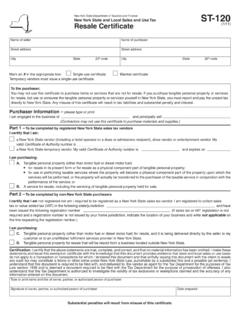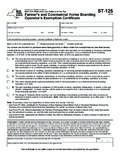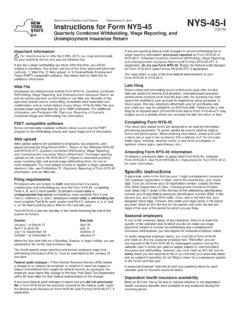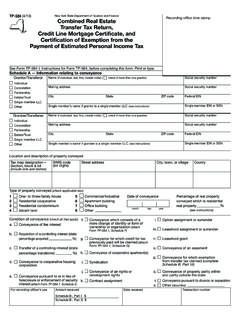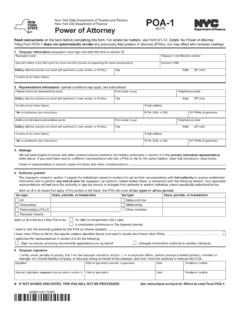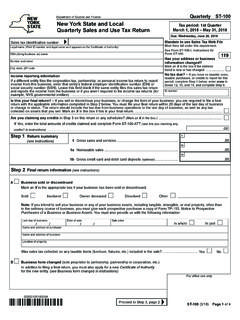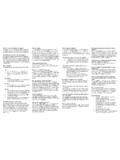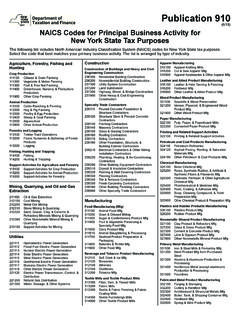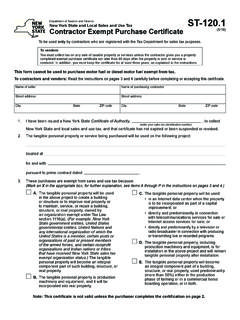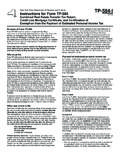Transcription of New York State Department of Taxation and Finance Office ...
1 New York State Department of Taxation and Finance TSB-M-06(5)I. Office of Tax Policy Analysis Income Tax Technical Services Division May 15, 2006. New York Tax Treatment of Nonresidents and Part- year Residents Application of the Convenience of the Employer Test to Telecommuters and Others This memorandum explains the Tax Department 's revised position concerning the application of the convenience of the employer test. The memorandum addresses situations where a nonresident or part- year resident employee whose assigned or primary work location is in New York State performs services for an employer at that location and at a home Office located outside of New York State . New York State nonresident individuals Section 601(e) of the New York State Tax Law imposes a personal income tax on a nonresident individual's taxable income that is derived from New York sources. The tax is equal to the tax computed as if the individual were a New York State resident for the entire year , reduced by certain credits, multiplied by the income percentage.
2 The numerator of the fraction used to compute the income percentage is the individual's New York source income. The New York source income of a nonresident is the sum of the items of income, gain, loss and deduction entering into federal adjusted gross income derived from or connected with New York sources, and any New York addition and subtraction modifications under sections 612(b) and 612(c) of the Tax Law that relate to income derived from New York sources ( , New York adjusted gross income from New York sources). The denominator of the fraction used to compute the income percentage is the nonresident's New York adjusted gross income from all sources for the entire year . In determining the New York source income of a nonresident employee, section (a) of the personal income tax regulations provides, in pertinent part: If a nonresident employee .. performs services for his employer both within and without New York State , his income derived from New York State sources includes that proportion of his total compensation for services rendered as an employee which the total number of working days employed within New York State bears to the total number of working days employed both within and without New York State .
3 However, any allowance claimed for days worked outside New York State must be based upon the performance of services which of necessity, as distinguished from convenience, obligate the employee to out-of- State duties in the service of his employer. [The convenience of the employer test.]. In making the allocation provided for in this section, no account is taken of nonworking days, including Saturdays, Sundays, holidays, days of absence because of illness or personal injury, vacation, or leave with or without pay. W A Harriman Campus, Albany NY 12227 -2- TSB-M-06(5)I. Income Tax May 15, 2006. Current application of the convenience of the employer test The instructions for Form IT-203-B, relating to Schedule A, Allocation of Wage and Salary Income to New York State , provide that: Work days are days on which you were required to perform the usual duties of your job. Any allowance for days worked outside New York State must be based upon the performance of services which, because of necessity (not convenience).
4 Of the employer, obligate the employee to out-of- State duties in the service of his employer. Such duties are those which, by their very nature, cannot be performed at the employer's place of business. Applying the above principles to the allocation formula, normal work days spent at home are considered days worked in New York State , and days spent working at home that are not normal work days are considered to be nonworking days. Note: Under this rule, days worked at home are considered New York work days only if the employee's assigned or primary work location is at an established Office or other bona fide place of business of the employer (hereinafter, a bona fide employer Office ) in New York State . If the employee's assigned or primary work location is at an established Office or other bona fide place of business of the employer outside New York State , then any normal work day worked at home would be treated as a day worked outside New York State .
5 Revised application of the convenience of the employer test For tax years beginning on or after January 1, 2006, it is the Tax Department 's position that in the case of a taxpayer whose assigned or primary Office is in New York State , any normal work day spent at the home Office will be treated as a day worked outside the State if the taxpayer's home Office is a bona fide employer Office (as determined below). Any day spent at the home Office that is not a normal work day would be considered a nonworking day. A normal work day means any day that the taxpayer performed the usual duties of his or her job. For this purpose, responding to occasional phone calls or emails, reading professional journals or being available if needed does not constitute performing the usual duties of his or her job. Factors to apply to determine if a home Office is a bona fide employer Office Employees should use the factors provided below to assist them in determining if their home Office constitutes a bona fide employer Office .
6 The factors are divided into three categories: the primary factor, secondary factors, and other factors. In order for an Office to be considered a bona fide employer Office , the Office must meet either: a) the primary factor, or b) at least 4 of the secondary factors and 3 of the other factors. -3- TSB-M-06(5)I. Income Tax May 15, 2006. Primary Factor The home Office contains or is near specialized facilities. If the employee's duties require the use of special facilities that cannot be made available at the employer's place of business, but those facilities are available at or near the employee's home, then the home Office will meet this factor. For example, if the employee's duties require the use of a test track to test new cars, and a test track is not available at the employer's offices in New York City, but is available near the employee's home, then the home Office will meet this factor. In the alternative, if the employee's duties require the use of specialized scientific equipment that is set up at the employee's home (or at a facility near the employee's home) but could physically be set up at the employer's place of business located in New York, then the home Office would not meet this factor.
7 Secondary Factors 1) The home Office is a requirement or condition of employment. If the employer requires the employee to work from his or her home Office as a condition of employment, the home Office will meet this factor. For example, if a written employment contract states the employee must work from home to perform specific duties for the employer, then the home Office will meet this factor. 2) The employer has a bona fide business purpose for the employee's home Office location. If the employer has a bona fide business purpose for establishing an Office in the locale where the employee's home is located, the home Office will meet this factor. For example, if the employee is an engineer working on several projects in his or her home State and it is necessary that the employee have an Office near these projects in order to meet project deadlines, then the home Office will meet this factor. 3) The employee performs some of the core duties of his or her employment at the home Office .
8 If some of the core duties of employment are performed at the home Office , then the home Office will meet this factor. For example, the core duties of a stock broker include the purchase and sale of stock. Accordingly, if the stock broker executes stock purchases and sales from the home Office , this would constitute performing some of the core duties at the home Office . However, if the stock broker merely reads business publications on the weekend, this would not constitute performing any core duties at the home Office . -4- TSB-M-06(5)I. Income Tax May 15, 2006. 4) The employee meets or deals with clients, patients or customers on a regular and continuous basis at the home Office . If an important part of the employee's duties include physically meeting with clients, patients or customers in the normal course of the employer's trade or business, and those meetings are performed on a regular and continuous basis at the home Office , then the home Office will meet this factor.
9 For example, the employer has clients located near the employee's home Office and the employee must meet with the clients once a week to perform the duties of his or her job. If the meetings with clients are on a regular and continuous basis at the employee's home Office , then the home Office will meet this factor. 5) The employer does not provide the employee with designated Office space or other regular work accommodations at one of its regular places of business. If the employer does not provide the employee with designated Office space or other regular work accommodations at one of its regular places of business, then the home Office will meet this factor. For example, an employer wishes to reduce the size of the Office space maintained in New York to decrease rental expenses and, therefore, no longer provides designated Office space or other regular work accommodations for one of its employees. Instead, the employer allows the employee to work from the employee's home.
10 If the employee must come to the Office , the employee must use the visitors cubicle, conference room, or other available space that is also used by the other employees of the company. In this instance, the home Office will meet this factor. 6) Employer reimbursement of expenses for the home Office . If the employer reimburses the employee for substantially all of the expenses ( , utility expenses, insurance) related to the home Office , or the employer pays the employee a fair rental value for the home Office space used and the employer furnishes or reimburses the employee for substantially all of the supplies and equipment used by the employee, then the home Office will meet this factor. For purposes of this factor, substantially all of the expenses means 80% or more of the expenses. Other factors 1) The employer maintains a separate telephone line and listing for the home Office . 2) The employee's home Office address and phone number is listed on the business letterhead and/or business cards of the employer.
